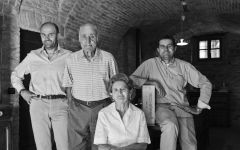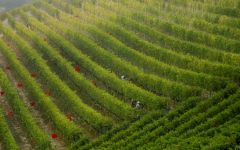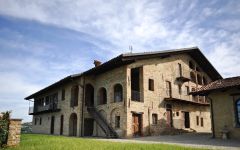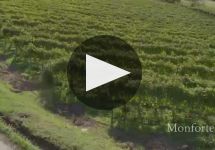Pecchenino Barolo San Giuseppe 2007
-
Wine
Spectator -
Wine
Enthusiast -
Robert
Parker -
James
Suckling


Product Details
Your Rating
Somm Note
Winemaker Notes
Professional Ratings
-
Wine Spectator
An intense, ripe raspberry core provides the foundation for floral, licorice, tobacco and mineral elements. This is pure and racy, yet also lean and sinewy—a real thoroughbred. Shows terrific balance and harmony. Best from 2015 through 2029.
-
Wine Enthusiast
Gorgeous fullness and generosity characterize this bold Barolo as do its aromas of black cherry, spice, teriyaki and toasted hazelnut. San Giuseppe presents a classic expression of Nebbiolo that is especially evident in the fine, polished nature of the mouthfeel.
-
Robert Parker's Wine Advocate
The 2007 Barolo San Giuseppe shows excellent fleshiness in its dark fruit. Shades of tobacco, licorice and flowers develop in the glass, adding further complexity, while darker balsamic notes are the last layers of flavor to emerge. This is a fairly delicate style that is likely to offer its greatest pleasure earlier rather than later. Anticipated maturity: 2014-2024.
-
James Suckling
So much strawberry on the nose. Perfumed and gorgeous. Full body, with a solid core of fruit and chewy tannins. Lacks a little bit of a center palate. But it should fill in nicely with bottle age. Best after 2014.
Other Vintages
2018-
Wine
Spectator -
James
Suckling -
Jeb
Dunnuck -
Robert
Parker
-
James
Suckling -
Wine
Spectator -
Wine &
Spirits -
Robert
Parker
-
Jeb
Dunnuck -
Robert
Parker
-
Wine &
Spirits -
James
Suckling -
Wine
Spectator -
Robert
Parker -
Wine
Enthusiast
-
James
Suckling -
Wine
Spectator -
Wine &
Spirits
-
James
Suckling -
Wine
Spectator
-
Wine
Spectator







The Company was founded at the end of the nineteenth century, in an area where Dolcetto vineyards have been a typical feature for centuries, as is documented by a writing that dates back to 1432, which is kept in the communal archives.
The farm has always been family run, and the land has passed from father to son throughout its history. The first historical evidence of the farm is from the beginning of the twentieth century, when the farm was led by Attilio Pecchenino (the grandfather) and had little more than 8 hectares of land. In the 70s, the farm was given to Marino Pecchenino (Attilio's son), and in 1987 to Orlando and Attilio (Marino's two sons) who currently own it and manage it. At present, after having recently bought a new farm (Bricco Botti), the total land owned by Pecchenino is approx. 25 hectares, all in the area of Dogliani. For a couple of year now, Pecchenino has expended much energy on making his dolcettos more elegant and appetizing abroad as well as in Italy. The results clearly show in his two main house Dolcettos: the San Luigi and the Siri d'Jermu that recently was upgraded to Dogliani DOCG status.
Pecchenino winery is managed in a sustainable fashion: Orlando is convinced that the quality of his wine is strictly related to the natural health of his vineyard. His main objective is that of growing the best possible grapes with the lowest possible impact on nature. In the vineyards, he opts for organic compost and avoids the use of any chemical products for weed or pest control; his treatments in the vineyards are all natural unless it becomes absolutely necessary.

Responsible for some of the most elegant and age-worthy wines in the world, Nebbiolo, named for the ubiquitous autumnal fog (called nebbia in Italian), is the star variety of northern Italy’s Piedmont region. Grown throughout the area, as well as in the neighboring Valle d’Aosta and Valtellina, it reaches its highest potential in the Piedmontese villages of Barolo, Barbaresco and Roero. Outside of Italy, growers are still very much in the experimentation stage but some success has been achieved in parts of California. Somm Secret—If you’re new to Nebbiolo, start with a charming, wallet-friendly, early-drinking Langhe Nebbiolo or Nebbiolo d'Alba.

The center of the production of the world’s most exclusive and age-worthy red wines made from Nebbiolo, the Barolo wine region includes five core townships: La Morra, Monforte d’Alba, Serralunga d’Alba, Castiglione Falletto and the Barolo village itself, as well as a few outlying villages. The landscape of Barolo, characterized by prominent and castle-topped hills, is full of history and romance centered on the Nebbiolo grape. Its wines, with the signature “tar and roses” aromas, have a deceptively light garnet color but full presence on the palate and plenty of tannins and acidity. In a well-made Barolo wine, one can expect to find complexity and good evolution with notes of, for example, strawberry, cherry, plum, leather, truffle, anise, fresh and dried herbs, tobacco and violets.
There are two predominant soil types here, which distinguish Barolo from the lesser surrounding areas. Compact and fertile Tortonian sandy marls define the vineyards farthest west and at higher elevations. Typically the Barolo wines coming from this side, from La Morra and Barolo, can be approachable relatively early on in their evolution and represent the “feminine” side of Barolo, often closer in style to Barbaresco with elegant perfume and fresh fruit.
On the eastern side of the Barolo wine region, Helvetian soils of compressed sandstone and chalks are less fertile, producing wines with intense body, power and structured tannins. This more “masculine” style comes from Monforte d’Alba and Serralunga d’Alba. The township of Castiglione Falletto covers a spine with both soil types.
The best Barolo wines need 10-15 years before they are ready to drink, and can further age for several decades.
